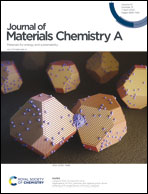A Sn doped, strained CuAg film for electrochemical CO2 reduction†
Abstract
The electrochemical CO2 reduction reaction (CO2RR) using renewably generated electricity under mild conditions is a promising and sustainable approach to convert CO2 to value-added chemicals. Cu and Cu alloys are considered to be potential catalysts for CO2 reduction among numerous catalysts. Unfortunately, the product selectivity and conversion efficiency during the CO2RR are severely limited by the unavoidable competitive hydrogen evolution reaction (HER). Here, we developed a facile deposition method based on magnetron co-sputtering to optimize the alloy composition of Cu. As a result, we found that CuAg electrode of Sn addition can effectively inhibit the HER during the CO2RR and improve the selectivity of CO, and the FE of CO can reach 93% at −0.85 V. The large lattice distortions and strain effect after Sn addition affect the electronic structure and further result in the downshift of the d-band center, which causes the Gibbs free energy of the formation of *H on the CuAgSn surface to increase dramatically. Although the formation energy barrier of *COOH doesn't decrease after Sn addition, the selectivity of CO is enhanced, owing to the selective suppression of the HER. This work provides an effective way to improve the CO2 reduction performance of binary alloys by adding a small amount of a third metallic element.



 Please wait while we load your content...
Please wait while we load your content...